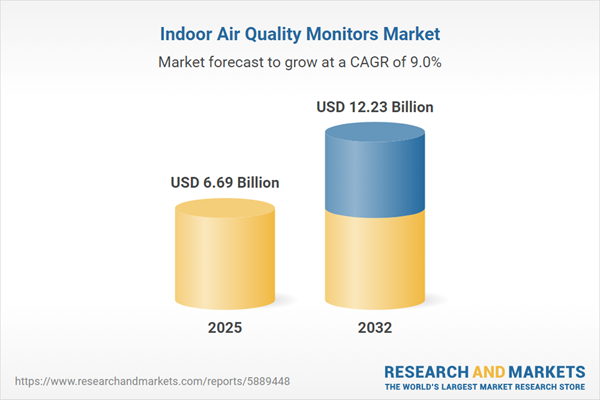Speak directly to the analyst to clarify any post sales queries you may have.
The indoor air quality monitors market is transforming how organizations manage workplace safety and compliance. As regulatory scrutiny grows and business expectations for healthy environments increase, advanced monitoring solutions have become essential for operational resilience and risk management.
Market Snapshot: Indoor Air Quality Monitors Market
The global indoor air quality monitors market is advancing rapidly, propelled by greater awareness of workplace health and the evolution of global compliance mandates. These changes are driving the widespread integration of monitoring systems into diverse sectors, including commercial real estate, healthcare, and manufacturing. Implementation enables organizations to access real-time, data-centric insights, supporting decision-making, risk mitigation, and operational responsiveness. Market demand continues to surge for solutions that deliver scalable monitoring, seamless system integration, and actionable analytics across both single-site and distributed facility portfolios.
Scope & Segmentation of the Indoor Air Quality Monitors Market
Understanding the market structure aids senior decision-makers in selecting and deploying monitoring solutions aligned with compliance, safety, and efficiency objectives. The following segmentation highlights core areas shaping procurement, risk management, and operational protocols across varied industries and geographies.
- Pollutants Measured: Devices are calibrated to detect key contaminants such as carbon dioxide, formaldehyde, ozone, volatile organic compounds, and particulate matter (PM2.5/PM10). Monitoring also extends to temperature and humidity, offering a comprehensive approach to workplace risk prevention.
- Product Types: Options range from portable units for spot checks and validation, to continuous stationary monitors for ongoing facility analytics, and wearable devices for mobile workforce protection. Selection ensures alignment with different operational workflows and regulatory contexts.
- End Users: Implementation occurs in commercial offices, educational institutions, healthcare environments, industrial complexes, and high-density residential settings. Each application area drives specific platform requirements and procurement strategies.
- Technologies: Core technologies include electrochemical sensors, laser-based analytics, metal oxide semiconductors, photoionization sensors, and non-dispersive infrared detection (NDIR). Adopting suitable technologies enables tailored detection for specific workplace risks and monitoring priorities.
- Distribution Channels: Devices are sourced via direct manufacturer engagement, OEM partnerships, specialized B2B e-commerce, and select retail providers. This diversity in procurement channels supports supply agility and resilience, matching the demands of multifaceted projects or expanding facility networks.
- Regional Coverage: Market analysis spans the Americas, Europe, Middle East & Africa, and Asia-Pacific, where region-specific regulatory landscapes and infrastructure capabilities shape deployment complexity and procurement decision-making.
- Leading Companies: Industry leaders—Honeywell International Inc., Siemens Aktiengesellschaft, Thermo Fisher Scientific Inc., TSI Incorporated, Sensirion AG, Vaisala Oyj, Aeroqual Ltd., Dylos Corporation, IQAir AG, and Kanomax Japan, Inc.—define technological benchmarks and delivery standards worldwide.
Key Takeaways for Senior Decision-Makers
- Integrating indoor air quality monitoring strengthens regulatory compliance and fortifies workplace safety culture, supporting consistent policy execution across single and distributed properties.
- Platforms connect seamlessly with broader building management systems, increasing the organization’s agility in adapting to evolving standards and compliance updates.
- Tailored device selection—spanning portable, stationary, and wearable forms—aligns with team mobility requirements, site layouts, and risk profiles to ensure proper coverage and responsiveness.
- Advanced sensor systems, combined with maintenance-friendly designs, support proactive exposure management and help reduce compliance gaps while limiting operational disruptions.
- Leveraging multiple procurement channels allows organizations to navigate economic or logistical shifts, maintaining supply continuity and supporting strategic sourcing decisions.
Tariff Impact: Navigating U.S. Policy Changes
Recent U.S. tariffs affecting components for indoor air quality monitors are contributing to increased cost pressures in procurement and supply operations. Organizations are responding by adjusting sourcing strategies, strengthening domestic assembly, and optimizing logistics to secure ongoing access to monitoring technologies.
Methodology & Data Sources
This market assessment combines executive interviews, independent market research, peer-reviewed laboratory datasets, and detailed regulatory evaluations. The blended methodology provides insights relevant to procurement scenarios and real-world facility management.
Why This Report Matters to B2B Leaders
- Clarifies the impacts of technology adoption and regulatory change, empowering more informed investment and risk management across facilities portfolios.
- Uncovers actionable trends and compliance drivers, enabling procurement teams to select and deploy monitoring solutions in complex and dynamic business environments.
Conclusion
Senior leaders will find the clarity needed to refine air quality management strategies, enhancing regulatory alignment and operational adaptability as workplace requirements continue to evolve.
Additional Product Information:
- Purchase of this report includes 1 year online access with quarterly updates.
- This report can be updated on request. Please contact our Customer Experience team using the Ask a Question widget on our website.
Table of Contents
3. Executive Summary
4. Market Overview
7. Cumulative Impact of Artificial Intelligence 2025
Companies Mentioned
The companies profiled in this Indoor Air Quality Monitors market report include:- Honeywell International Inc.
- Siemens Aktiengesellschaft
- Thermo Fisher Scientific Inc.
- TSI Incorporated
- Sensirion AG
- Vaisala Oyj
- Aeroqual Ltd.
- Dylos Corporation
- IQAir AG
- Kanomax Japan, Inc.
Table Information
| Report Attribute | Details |
|---|---|
| No. of Pages | 183 |
| Published | October 2025 |
| Forecast Period | 2025 - 2032 |
| Estimated Market Value ( USD | $ 6.69 Billion |
| Forecasted Market Value ( USD | $ 12.23 Billion |
| Compound Annual Growth Rate | 9.0% |
| Regions Covered | Global |
| No. of Companies Mentioned | 11 |









